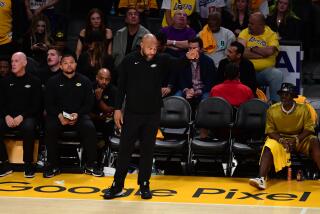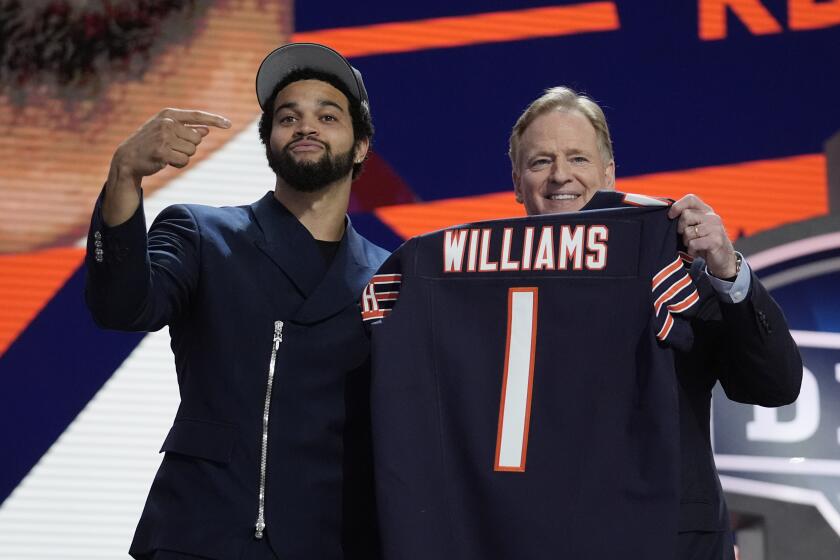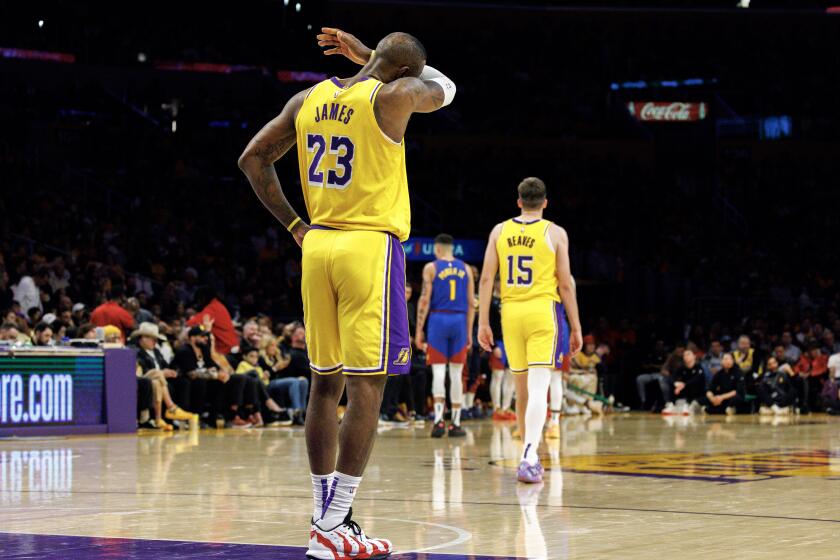Changing the Signal Callers
The New York Jets want San Diego’s Drew Brees to be their next quarterback.
It’s obvious, undeniable, unequivocal ...
Unless, of course, they choose to pursue his backup, Philip Rivers.
Then again, Rivers could wind up with the Tennessee Titans, where he would be reunited with offensive coordinator Norm Chow, who coached him at North Carolina State ...
Unless Chow and the Titans have a chance to land USC’s Matt Leinart, the likely No. 1 pick in next spring’s draft.
But if the Titans have their heart set on Leinart, they’d better get in line. Cleveland, Detroit, Dallas, Arizona and Miami probably will be in the market for new quarterbacks too. Or maybe the Titans will promote promising backup Billy Volek and send 33-year-old Steve McNair to the Jets, where he could play under former Tennessee offensive coordinator Mike Heimerdinger.
The NFL trading deadline has passed, but the rumors are only beginning. There could be more quarterback shuffling next off-season than any in memory, with more than one-third of the league at least considering changes.
For every etched-in-stone starter in one city, there’s an etched-in-butter starter in another. For every Tom Brady, Donovan McNabb or Peyton Manning, there’s a Joey Harrington, Kyle Orton or Anthony Wright.
The first dominoes to fall could be from teams on opposite coasts with opposite roster situations. The Chargers have too many quarterbacks; the Jets have too few.
Rivers is the best-paid benchwarmer in football, a $14-million-bonus man who for the last 1 1/2 seasons has been holding a clipboard for Brees, who came to life last season and led San Diego to the playoffs. If Brees pulls off an encore -- he has only one interception in the last four games for the suddenly surging Chargers -- his team will be hard-pressed to let him go.
But it’s far too costly these days for a franchise to hold onto two big-money quarterbacks. Long gone are the days of Roger Staubach and Danny White, or Joe Montana and Steve Young.
So either Brees or Rivers is on his way out. And the team in most dire need is the Jets, who are limping along with 41-year-old Vinny Testaverde while the inconsistent Chad Pennington recovers from a shoulder injury that may prevent him from throwing until next spring.
This week, before the trading deadline, the Chargers swapped backup quarterbacks with Miami, sending Cleo Lemon to the Dolphins for A.J. Feeley, a more seasoned backup. It was more evidence that San Diego is planning for a future without either Rivers or Brees.
There could be changes all over the league by next season. In Detroit, things are so rough that the Lions might replace Harrington with Jeff Garcia, who couldn’t keep a job in Cleveland. In the three-plus seasons since the Lions made Harrington the No. 3 pick, they have gone 3-13, 5-11, 6-10 and now are 2-3.
Although Coach Steve Mariucci said it would “be crazy to point the finger at one person,” his quarterback has an uncharacteristically good read on this one.
“It doesn’t take a rocket scientist to figure out things are not going very well right now,” Harrington told reporters this week.
At least Harrington has his youth, and the chance to reinvent himself, the way Brees did. The sun is rapidly setting on several other starters, who range in age from 33 to 36: Drew Bledsoe, Kerry Collins, Trent Dilfer, Kurt Warner, Mark Brunell, Trent Green, McNair, and, of course, Brett Favre.
When a team is struggling, making a change at quarterback often seems to be the best place to start. Then again, to some, Tim Couch sounded like a good idea. So did Akili Smith, Cade McNown, Ryan Leaf
*
One yard and one foot.
That pretty much sums up the 2004 season of Seattle running back Shaun Alexander. He fell one yard short of tying Curtis Martin for the NFL rushing title, then, in a moment of selfish indulgence, inserted one foot in his mouth by complaining he felt “stabbed in the back” by the Seahawks for not giving him the ball more.
It was a gripe that didn’t play well in Seattle, where the Seahawks haven’t won a playoff game since Alexander was in second grade.
Already, a lot of people saw him as a good back, but not a great one, who was reaping the benefits of a run-friendly offense with elite blockers up front. Making matters worse, he gained only 40 yards on a season-low 2.7 yards a carry in a first-round playoff loss to St. Louis.
The Seahawks, like just about every other NFL franchise, have tried to tear a page from New England’s playbook. The Patriots’ philosophy -- no player is bigger than the team -- has led to three Super Bowl victories in four seasons. And here the Seahawks had a star player essentially admitting that his personal production mattered most.
So the challenge for Alexander this season wasn’t only about winning football games but also about winning back Seattle and the Seahawks.
So far, he’s doing a good job. He has 12 rushing touchdowns -- no other NFL team has that many -- and spearheads the league’s No. 1 offense heading into Sunday’s game against Dallas.
Just as important as the yards, Alexander is becoming a better fit in Coach Mike Holmgren’s offense, and that speaks well for his future in Seattle. Alexander has a one-year deal and the Seahawks agreed not to put the franchise-player tag on him after this season. That means he will have a chance to test the market.
“Where I am impressed even more with him this year is his pass protection,” Holmgren said. “There are not many backs that love to do that. Let’s be honest. They like to run and do those things and score touchdowns. But the dirty work, they have to do it because it’s their job, and he has really tried, in my opinion, very hard to improve that part of his game. And that to me was the last thing he had to do to be the complete guy.”
*
Minnesota center Matt Birk on the scandal-stained Vikings: “I think we put the ‘fun’ in dysfunctional.”
More to Read
Get our high school sports newsletter
Prep Rally is devoted to the SoCal high school sports experience, bringing you scores, stories and a behind-the-scenes look at what makes prep sports so popular.
You may occasionally receive promotional content from the Los Angeles Times.







